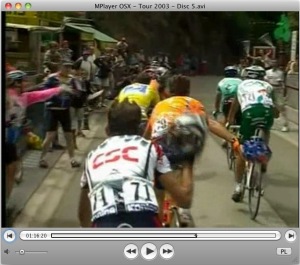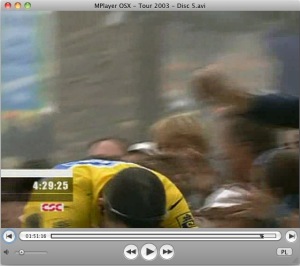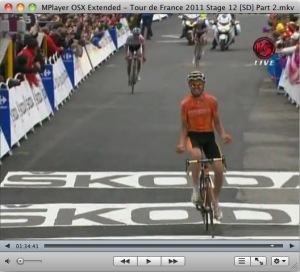 Since you all loved it so much when I compared Tours de France earlier this week (and since you all took such care to read the admonitions about my data) I’ve decided to try it again for yesterday’s Luz Ardiden stage finish. While I normally have a dim view toward comparing climbing times between races, the contrasts between the ascents of this climb in 2003 and 2011 were too sharp not to look into.
Since you all loved it so much when I compared Tours de France earlier this week (and since you all took such care to read the admonitions about my data) I’ve decided to try it again for yesterday’s Luz Ardiden stage finish. While I normally have a dim view toward comparing climbing times between races, the contrasts between the ascents of this climb in 2003 and 2011 were too sharp not to look into.
So I obtained digital copies of WCP’s ostensibly unedited DVD from 2003’s Stage 15, and a screencap of yesterday’s live, commercial-free finale on VS, and rolled them each back to a recognizable start point—the moment each heads of state group exits the Pont Napoleon. Since it’s where the riders removed their helmets back in 2003, I think it’s a solid choice for the official climb start.
I realize there are conspiracy theorists among you who will seize on the different angles and road surfaces, but I assure you, it’s the same bridge. You can see the same monument in the approach to it each year.

I likewise stopped the tape as each stage winner and heads of state group crossed the line at the top of the hill, put both figures into a spreadsheet, and began calculating elapsed times. The twisting approach and short finishing straight appear to be identical between the two ascents, so assuming that nothing funky happened in encoding either of the videos, the numbers are about as accurate and verifiable as any you’ll find.
However, Sammy Sanchez, as he is wont to do, decided to make things complicated. He escaped on the descent leading into Luz Ardiden, and crossed the bridge just ahead of the other leaders. You can’t really see him as he exits, because the camera cuts back to the chase, so I used the moment of the cut as the timestamp for his crossing.
So, what did the numbers look like?
| 2003: | 2011: | ||
| Climb Winner | 0:34:56 | Climb Winner | 0:38:51 |
| Climb 1st Group | 0:35:40 | Climb 1st Group | 0:39:00 |
| Winner VAM | 1,687 | Winner VAM | 1,517 |
| Group VAM | 1,652 | Group VAM | 1,511 |
| Winner W/Kg | 6.13 | Winner W/Kg | 5.51 |
| Group W/Kg | 6.01 | Group W/Kg | 5.49 |
| Time Diff | %Change in VAM | ||
| Climb Winner | 0:03:55 | Winner VAM | -10.08 |
| Climb Group | 0:03:20 | Group VAM | -8.55 |
Before I begin drawing any conclusions, let me just say that I’m well aware yesterday’s finish (despite a very similar profile) came at the end of 212km, compared to 160km in 2003. I also know that the lead group was much smaller in ’03, and that today’s finish had a decent tailwind, and that Armstrong’s 2003 time includes a number of historic mishaps. These, and the innumerable other things that make each new bike race interesting, are the reasons I generally think comparing times between ascents is stupid.
But the differences here are enormous, to the point that they negate almost any imaginable interference. The 10% drop in VAM (calculated, along with watts-per-kilo, from Strava’s figures of 982m and 7.5%) is insane. It basically says that after 5.5 hours in the saddle, a Cat 1 climb, and the Tourmalet, the top pros slowed down enough that even I can (very briefly and while fresh) reach a similar ascent speed.
Because Sammy Sanchez started ahead of the rest, it’s possible that Frank Schleck had a faster time it was actually Frank Schleck who had the fastest climb on the day—38:39, VAM of 1524, W/Kg of 5.54. But the fact that there aren’t any glaring differences in performance between the winner and the other heads of state is another striking change. In 2003, Carlos Sastre finished three minutes down on Armstrong and was 11th. That same margin on today’s stage barely put you in the top 25.
So what’s the cause? I’m sure many of you will go on in the comments section about people marking a sub-par Contador, or fewer GC riders around to kick up the tempo, or an overall race un-impacted by time-trials, or the flogging Leopard-Trek doled out over the Tourmalet, or any other of the innumerable, pleasant reasons why yesterday’s finish cannot possibly be compared to anything, and that I’m a fool for even trying.
So I’ll just direct you to this fact: the difference between Lance Armstrong’s ’03 time and Sanchez’ mark yesterday is almost identical to the amount of time one Thomas Voeckler lost to Armstrong in the Frenchman’s first day of high mountain maillot jaune defense, way back in 2004.
A peloton at two speeds? C’est possible.



Sweet post. Very Interesting.
The w/kg you have listed for yesterday seems suspiciously low. I know a few local cat 1’s and a fast local pro that could do that after 200k.
haters gonna hate but the insight is much appreciated.
Although I’m pretty sure PEDs were involved in ’03 (and I bet as well yesterday), the difference can be explained totally by race tactics involved in the specific stage. If I recall correctly, there was a greater difference on GC going into the stage, meaning there was more incentive to NOT finish with the same time as the competition. Also, on the lower half of the climb Lance fell, which caused both him and his competition to ride as hard as possible for a fairly long time. Frank didn’t attack yesterday until after the mid-point of the climb. And, the other three big contenders stayed next to each other until the top.
that the winner yesterday would have been blown out the back of the ’03 group says a lot for me
Yes, the race context does influence how fast a final climb is climbed, but it’s not just this climb. People have been doing these type of analyses of climbing speeds for the last couple of years and the climbing speeds are consistently slower now than they were 10 years ago. All of the evidence seems to point to the introduction of the blood passport in 2008 as being a real turning point. Is there still doping? Sure, we’ve had a rider test positive already, and there are probably others, but I’m convinced that it’s a lot less prevalent than it used to be.
Why is it that Basso was so cooked in the Tour last year after winning the Giro, and now even Contador appears to be suffering the same fate, when Pantani seemed to have no trouble winning both in 1998? They now have the expectation that if they use the old “recovery” methods, they might get caught.
Seems like Alpe d’Huez would be another good climb for further analysis. It’s climbed frequently and it might be possible to find winning times for each year without having to go back to the video?
phenomenal assessment Cosmo
thanks…now to mull it all over
@steevo, i’m not sure your logic is right there, i’m sure there are some riders that could pound that speed after 200km, but could they do it after leopard-trek pounded them up the tourmalet and after a cat 1 climb, if they could do that with relative ease, they’d be in the pro peleton at this point
@coramoor
further to your point, also add 10 days of racing leading into the stage
Basso did the climb both times, right? Hanging on for dear life in ’03, and now leading the charge in ’11, about four minutes slower? If he is, in fact, clean today, and he truly did “fail to dope” when he attempted it in the past, this might be some indication of what a clean rider looked like then vs. now. But those are some big ifs.
Great post … thanks indeed for the effort.
@Steve, tactics make a difference and may have affected the climb, but to assert that 4 minutes are lost solely to tactics is highly unrealistic. If Frank (or others) could have climbed 4 minutes faster they would have. We know Contador could not have climbed faster because he was at his limit and lost time–and nobody in their right mind would leave 4 minutes on the road for him to take back.
On a climb with a tailwind the tactics take a backseat to physical ability.
@Cosmo, these numbers are so shocking that it might be useful to get an additional source on the ’03 climb time, just to verify. Also, Plateau de Beille’s time could be extra useful, since both Contador and Basso have climbed it and received the winner’s time (Basso obviously lost the sprint to Lance in ’04). Great potential f
Er, “for contrast.”
If you want a little more detail in the analysis. Their conclusions are basically the same (though I think strava might be underestimating power output).
https://www.sportsscientists.com/2011/07/tour-de-france-luz-ardiden-analysis-and.html
Nice post! Would be cool to see this kind of analysis averaged over more climbs, which would somewhat smooth out stage-specific race tactics etc..
CAT 1’s who could do it after 200k? You’re kidding, right? Seriously, please tell me you are?
This is the more normal speed after you do a fairly large Col and then have a world-class squad drill it to the base of the climb and then they ride a tempo which is so hard no one can really come off the front. There is not a CAT I anywhere that can do this with 2 weeks of racing in their legs. Not going to happen – puhlease. I hate wattage numbers, I watched a stage with a guy who claimed he could be cavendish cause well, he has good numbers. I swear powermeters are killing the sport.
This is a great post and EVERYONE should read it. All the GCs had EVERY reason to attack and go as fast as they possibly could – they had no reason not to. Good job.
nice return to form Cosmo…I enjoy contemplating your thought experiments. Before your observation and measurement of the 1995 and 2011 Luz climbs I was living in a world where both Armstrong’s and Sanchez’s times seemed equally plausible (with or without PED’s). Perhaps reality will eventually catch up with the “two speeds” hypothesis and Novitzky’s investigation will open the box for us to see that the hammer has fallen and the cat is dead…
*woops, I meant “2003 and 2011 Luz climbs”…my girlfriend was just watching an old epsisode of 90210 while I was typing…maybe that’s why 1995 popped into my head 😀
1. Nice post Cosmo, much better than the last one.
2. @steevo, @velomonkey
https://www.recordholders.org/en/records/roller1.html
i bet these records won’t be broken by any pro in the peloton, but he holds them because he isn’t a professional rider.
But seriously if anyone can produce 5.5 W/kg (inclusive gear and bike) for half an hour after 200k of racing, I wonder why they are not in at least a PCT team, cause face it even Pantani’s record ride up Alpe d’Huez was 6.2 in 1997, and we know he was on stuff.
Figures:
https://www.sportmedinfo.de/radsport.htm
https://www.olivierbernhard.com/platform/content/element/867/wattmessung.pdf
though on German, but the tables are still comprehensive
All climbing records are from the end of 90s and beginning of 2000, and the high tide is roughly around 6.1-6.2 W/kg. So 5.5 W/kg sounds realistically, even in the context of them not going at their limit and maybe being clean.
like cycling all the way!